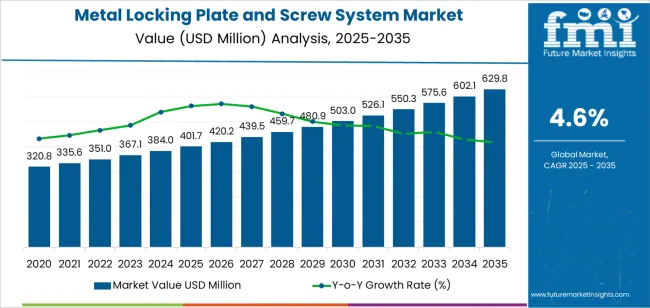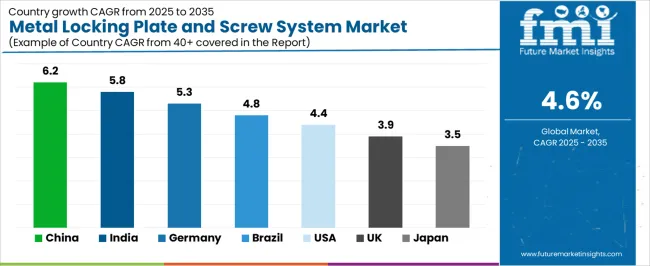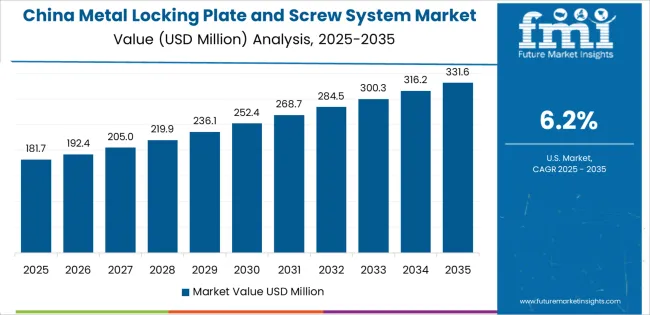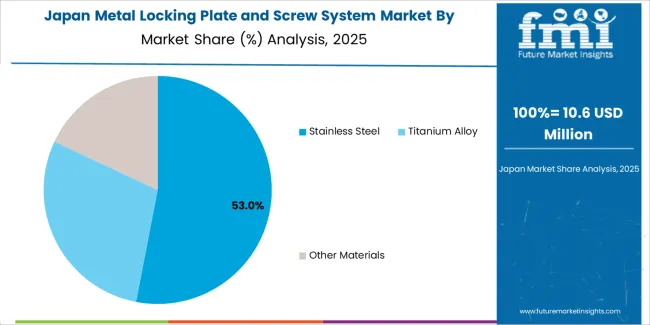The metal locking plate and screw system market is valued at USD 401.7 million in 2025 and is projected to reach USD 629.9 million by 2035, growing at a CAGR of 4.6% over the forecast period. This expansion represents an absolute increase of USD 228.2 million and reflects the rising number of orthopedic trauma cases, aging population dynamics, and widespread adoption of advanced internal fixation systems in surgical practice. The market sits at the intersection of orthopedic reconstruction and trauma repair, where locking mechanisms provide superior angular stability compared to conventional plating systems, particularly in osteoporotic and comminuted fractures. Stainless steel systems are expected to account for 52.3% of usage in 2025, driven by their mechanical strength, cost efficiency, and long-standing clinical familiarity across hospital networks. Titanium alloy variants will expand at a faster pace due to their biocompatibility advantages and increasing preference in complex orthopedic procedures.
Hospitals will continue to represent approximately 68.7% of total demand in 2025, reinforced by higher surgical case volumes, robust procurement pipelines, and integration with orthopedic trauma centers. Growth across Asia Pacific is notable, supported by surgical infrastructure expansion, training program development, and increased local manufacturing presence. North America and Europe maintain strong adoption based on procedural standardization and well-established orthopedic care pathways. The competitive environment is led by Stryker, Smith & Nephew, Zimmer Biomet, Acumed, and KLS Martin, each advancing plate geometry, thread interface design, and material processing to enhance fixation reliability and surgical efficiency.

Clinical adoption patterns in the market reflect broader medical trends toward high-performance, biocompatible systems that provide both surgical efficiency benefits and improved patient outcomes. The market benefits from the growing popularity of locking plate applications, which are recognized for their advanced stability integration and surgeon-friendly approach to fracture management. The versatility of metal locking systems as both standalone fixation devices and integrated surgical components supports sustained demand across multiple procedure types and complexity levels.
Regional implementation patterns vary significantly, with Asian markets showing strong preference for titanium alloy implementations, while European markets demonstrate increasing adoption of stainless steel solutions alongside conventional fixation systems. The orthopedic landscape continues to evolve with sophisticated and feature-rich implant products gaining traction in mainstream healthcare facilities, reflecting surgeon willingness to invest in proven fixation technology improvements and patient-oriented features.
The competitive environment features established orthopedic device companies alongside specialized implant providers that focus on unique material capabilities and advanced manufacturing methods. Production efficiency and product development optimization remain critical factors for market participants, particularly as material costs and regulatory compliance continue to fluctuate. Distribution strategies increasingly emphasize multi-channel approaches that combine traditional medical supply chains with direct manufacturer partnerships through technology licensing agreements and system integration contracts.
Market consolidation trends indicate that larger orthopedic manufacturers are acquiring specialty implant companies to diversify their product portfolios and access specialized material processing segments. Original equipment integration has gained momentum as healthcare systems seek to differentiate their offerings while maintaining competitive cost structures. The emergence of specialized locking variants, including titanium and stainless steel options, reflects changing surgical priorities and creates new market opportunities for innovative fixation system developers. Manufacturing automation and quality control improvements enable consistent product scaling while maintaining traditional biomechanical characteristics that surgeons expect from established implant materials.
Between 2025 and 2030, the market is projected to expand from USD 401.7 million to USD 503.0 million, resulting in a value increase of USD 101.3 million, which represents 44.4% of the total forecast growth for the decade. This phase of development will be shaped by increasing adoption of titanium alloy systems, rising demand for hospital-based surgical solutions, and growing focus on fixation stability features with enhanced biomechanical characteristics. Medical device manufacturers are expanding their processing capabilities to address the growing demand for specialized locking implementations, advanced material options, and procedure-specific offerings across surgical segments.
| Metric | Value |
|---|---|
| Estimated Value (2025E) | USD 401.7 million |
| Forecast Value (2035F) | USD 629.9 million |
| Forecast CAGR (2025-2035) | 4.60% |
From 2030 to 2035, the market is forecast to grow from USD 503.0 million to USD 629.9 million, adding another USD 126.9 million, which constitutes 55.6% of the overall ten-year expansion. This period is expected to be characterized by the expansion of clinical application systems, the integration of innovative fixation solutions, and the development of specialized implant implementations with enhanced stability profiles and extended performance capabilities. The growing adoption of advanced alloy formulations will drive demand for metal locking systems with superior biocompatibility characteristics and compatibility with modern surgical technologies across trauma surgery operations.
Between 2020 and 2025, the market experienced steady growth, driven by increasing demand for stainless steel systems and growing recognition of locking mechanisms as essential components for modern fracture fixation programs across trauma surgery and orthopedic applications. The market developed as medical manufacturers recognized the potential for locking solutions to provide both biomechanical stability benefits and operational advantages while enabling streamlined surgical protocols. Technological advancement in material science and application-based development began focusing the critical importance of maintaining implant performance and surgeon acceptance in diverse surgical environments.
Market expansion is being supported by the increasing global demand for advanced orthopedic fixation systems and the corresponding need for metal implant technologies that can provide superior stability benefits and biomechanical advantages while enabling enhanced surgical outcomes and extended compatibility across various trauma surgery and orthopedic applications. Modern surgeons and orthopedic specialists are increasingly focused on implementing proven implant technologies that can deliver effective fracture stabilization, minimize traditional fixation dependency, and provide consistent performance throughout complex surgical configurations and diverse patient conditions. Metal locking systems proven ability to deliver exceptional stability efficacy against traditional alternatives, enable advanced surgical integration, and support modern fracture management protocols makes it an essential component for contemporary orthopedic and trauma surgery operations.
The growing focus on patient outcomes and surgical efficiency optimization is driving demand for metal locking systems that can support large-scale clinical requirements, improve fixation outcomes, and enable advanced surgical procedures. Surgeon preference for products that combine effective stability with proven biomechanical performance and compatibility benefits is creating opportunities for innovative locking implementations. The rising influence of minimally invasive surgical trends and fixation performance awareness is also contributing to increased demand for metal locking systems that can provide advanced features, seamless surgical integration, and reliable performance across extended treatment periods.
The metal locking plate and screw system market is poised for steady growth and technological advancement. As medical device manufacturers across North America, Europe, Asia-Pacific, and emerging markets seek systems that deliver exceptional fixation quality, advanced locking capabilities, and reliable performance options, metal locking solutions are gaining prominence not just as surgical implants but as strategic enablers of surgical technologies and advanced fixation functionality.
Rising titanium alloy adoption in Asia-Pacific and expanding hospital-based initiatives globally amplify demand, while manufacturers are leveraging innovations in material engineering, advanced alloy integration, and stability management technologies.
Pathways like hospital implementations, trauma surgery platforms, and specialized orthopedic solutions promise strong margin uplift, especially in premium product segments. Geographic expansion and product diversification will capture volume, particularly where local surgical preferences and advanced technology adoption are critical. Regulatory support around implant safety standards, fixation efficacy protocols, and biocompatibility requirements give structural support.
The market is segmented by material, application, end user, plate type, screw diameter, surgical approach, distribution channel, price range, and region. By material, the market is divided into stainless steel, titanium alloy, and other materials categories. By application, it covers hospital, clinic, and ambulatory surgical centers segments. By end user, it encompasses orthopedic surgeons, trauma surgeons, general surgeons, and others. By plate type, the market includes compression plates, reconstruction plates, bridging plates, and specialty plates. By screw diameter, the market includes 2.0-2.7mm, 2.8-3.5mm, 3.6-4.0mm, and above 4.0mm. By surgical approach, the market is categorized into open reduction, minimally invasive, and percutaneous categories. By distribution channel, the market is divided into direct sales, distributors, and hospital procurement. By price range, the market includes premium, mid-range, and economy. Regionally, the market is divided into North America, Europe, East Asia, South Asia & Pacific, Latin America, and the Middle East & Africa.

The stainless steel segment is projected to account for 52.3% of the market in 2025, reaffirming its position as the leading material category. Orthopedic surgeons and medical device manufacturers increasingly utilize stainless steel implementations for their superior biocompatibility when operating across diverse surgical platforms, excellent mechanical properties, and widespread acceptance in applications ranging from basic trauma fixation to complex orthopedic procedures. Stainless steel technology's established processing methods and proven stability capabilities directly address the surgeon requirements for dependable fixation solutions in complex surgical environments.
This material segment forms the foundation of modern surgical adoption patterns, as it represents the implementation with the greatest market penetration and established clinical acceptance across multiple procedure categories and complexity levels. Manufacturer investments in steel standardization and system consistency continue to strengthen adoption among medical device producers and surgical companies. With surgeons prioritizing stability and biocompatibility, stainless steel implementations align with both performance preferences and cost expectations, making them the central component of comprehensive surgical fixation strategies.

Hospital applications are projected to represent 68.7% of metal locking plate and screw system demand in 2025, highlighting their critical role as the primary application channel for surgical fixation across trauma surgery, orthopedic operations, and complex surgical procedures. Hospital systems prefer metal locking systems for surgical use for their exceptional stability characteristics, scalable surgical options, and ability to enhance surgical outcomes while ensuring consistent fixation quality throughout diverse surgical platforms and procedural operations. Positioned as essential fixation components for modern hospital operations, metal locking solutions offer both technological advantages and surgical efficiency benefits.
The segment is supported by continuous innovation in surgical technologies and the growing availability of specialized implementations that enable diverse surgical requirements with enhanced stability uniformity and extended performance capabilities. Hospital systems are investing in advanced technologies to support large-scale surgical integration and procedure development. As surgical precision trends become more prevalent and fixation performance awareness increases, hospital applications will continue to represent a major implementation market while supporting advanced surgical utilization and technology integration strategies.
The metal locking plate and screw system market is advancing steadily due to increasing demand for advanced orthopedic fixation systems and growing adoption of metal implant technologies that provide superior stability characteristics and biomechanical benefits while enabling enhanced surgical outcomes across diverse trauma surgery and orthopedic applications. The market faces challenges, including complex material formulation requirements, evolving medical regulations, and the need for specialized surgical expertise and performance programs. Innovation in materials science and advanced manufacturing systems continues to influence product development and market expansion patterns.
The growing adoption of advanced surgical fixation, sophisticated stability management capabilities, and orthopedic procedure awareness is enabling system developers to produce advanced metal locking solutions with superior biomechanical positioning, enhanced stability profiles, and seamless integration functionalities. Advanced surgical fixation systems provide improved procedural outcomes while allowing more efficient surgical workflows and reliable performance across various surgical applications and patient conditions. Developers are increasingly recognizing the competitive advantages of medical integration capabilities for market differentiation and stability positioning.
Modern metal locking system providers are incorporating advanced metallurgical technology, stability protocol integration, and sophisticated manufacturing solutions to enhance surgical appeal, enable intelligent fixation features, and deliver value-added solutions to medical customers. These technologies improve implant performance while enabling new market opportunities, including multi-component systems, optimized surface treatments, and enhanced biocompatibility characteristics. Advanced material integration also allows developers to support comprehensive surgical implant technologies and market expansion beyond traditional fixation approaches.

| Country | CAGR (2025-2035) |
|---|---|
| China | 6.2% |
| India | 5.8% |
| Germany | 5.3% |
| Brazil | 4.8% |
| United States (USA) | 4.4% |
| United Kingdom (UK) | 3.9% |
| Japan | 3.5% |
The market is experiencing steady growth globally, with China leading at a 6.2% CAGR through 2035, driven by expanding healthcare infrastructure, growing orthopedic surgery modernization programs, and significant investment in medical device development. India follows at 5.8%, supported by increasing trauma surgery capacity expansion, growing medical technology integration patterns, and expanding healthcare infrastructure. Germany shows growth at 5.3%, focusing medical device leadership and implant development. Brazil records 4.8%, focusing on expanding healthcare capabilities and medical technology modernization. USA exhibits 4.4% growth, focusing surgical innovation excellence and premium device development. UK demonstrates 3.9% growth, prioritizing advanced medical technology development and surgical procedure trends. Japan shows 3.5% growth, supported by medical technology initiatives and quality-focused manufacturing patterns.
The report covers an in-depth analysis of 40+ countries, top-performing countries are highlighted below.

Revenue from metal locking plate and screw system in China is projected to exhibit robust growth with a CAGR of 6.2% through 2035, driven by expanding healthcare capacity and rapidly growing medical integration supported by government initiatives promoting medical device development. The country's strong position in healthcare modernization and increasing investment in medical infrastructure are creating substantial demand for advanced locking implementations. Major medical device manufacturers and technology companies are establishing comprehensive integration capabilities to serve both domestic surgical demand and expanding export markets.
Revenue from metal locking plate and screw system in India is expanding at a CAGR of 5.8%, supported by the country's growing healthcare sector, expanding medical technology capacity, and increasing adoption of surgical fixation technologies. The country's initiatives promoting healthcare modernization and growing medical development awareness are driving requirements for technology-integrated surgical systems. International medical device providers and domestic healthcare companies are establishing extensive manufacturing and integration capabilities to address the growing demand for advanced fixation solutions.
Revenue from metal locking plate and screw system in Germany is expanding at a CAGR of 5.3%, supported by the country's medical device heritage, strong focus on surgical technology, and robust demand for advanced implant systems in orthopedic and trauma applications. The nation's mature medical sector and technology-focused operations are driving sophisticated locking implementations throughout the healthcare industry. Leading manufacturers and medical specialists are investing extensively in implant development and advanced integration technologies to serve both domestic and international markets.
Brazil is growing at a CAGR of 4.8%, driven by the country's expanding healthcare sector, growing medical programs, and increasing investment in medical device development. Brazil's large healthcare market and commitment to medical advancement are supporting demand for diverse locking solutions across multiple surgical segments. Manufacturers are establishing comprehensive integration capabilities to serve the growing domestic market and expanding medical opportunities.
USA is expanding at a CAGR of 4.4%, supported by the country's advanced medical technology sector, strategic focus on surgical solutions, and established healthcare capabilities. USA's medical innovation leadership and technology integration are driving demand for specialized locking implementations in premium procedures, hospital applications, and advanced surgical systems. Manufacturers are investing in comprehensive technology development to serve both domestic specialty markets and international quality applications.
UK is growing at a CAGR of 3.9%, driven by the country's focus on medical technology advancement, focus on premium procedure innovation, and strong position in surgical development. UK's established medical innovation capabilities and commitment to technology diversification are supporting investment in specialized locking technologies throughout major medical regions. Industry leaders are establishing comprehensive technology integration systems to serve domestic premium procedure production and surgical applications.

Revenue from metal locking plate and screw system in Japan is expanding at a CAGR of 3.5%, supported by the country's medical excellence initiatives, growing quality technology sector, and strategic focus on advanced product development. Japan's advanced quality control capabilities and integrated medical systems are driving demand for high-quality locking platforms in premium procedures, medical technology, and advanced surgical applications. Leading manufacturers are investing in specialized capabilities to serve the stringent requirements of technology-focused medical and premium surgical industries.

The metal locking plate and screw system market in Europe is projected to grow from USD 115.2 million in 2025 to USD 181.4 million by 2035, registering a CAGR of 4.7% over the forecast period. Germany is expected to maintain its leadership position with a 38.7% market share in 2025, growing to 39.8% by 2035, supported by its strong medical device engineering culture, sophisticated surgical capabilities, and comprehensive healthcare industry serving diverse metal locking system applications across Europe.
France follows with a 16.2% share in 2025, projected to reach 15.9% by 2035, driven by robust demand for surgical technologies in hospital applications, advanced medical programs, and orthopedic markets, combined with established healthcare infrastructure and technology integration expertise. The United Kingdom holds a 13.8% share in 2025, expected to reach 13.4% by 2035, supported by strong medical technology sector and growing premium surgical activities. Italy commands a 12.1% share in 2025, projected to reach 11.7% by 2035, while Netherlands accounts for 8.3% in 2025, expected to reach 8.6% by 2035. Spain maintains a 6.4% share in 2025, growing to 6.7% by 2035. The Rest of Europe region, including Nordic countries, Eastern Europe, Belgium, Poland, and other nations, is anticipated to maintain momentum, with its collective share moving from 4.5% to 3.9% by 2035, attributed to increasing healthcare modernization in Eastern Europe and growing technology penetration in Nordic countries implementing advanced surgical programs.

The market is characterized by competition among established orthopedic device companies, specialized implant technology developers, and integrated medical solution providers. Companies are investing in materials research, manufacturing optimization, advanced implant system development, and comprehensive medical portfolios to deliver consistent, high-quality, and procedure-specific metal locking solutions. Innovation in advanced stability integration, fixation enhancement, and surgical compatibility improvement is central to strengthening market position and competitive advantage.
Stryker leads the market with a 18.7% market share, offering comprehensive medical technology solutions including quality implant platforms and advanced integration systems with a focus on premium and hospital surgical applications. Smith & Nephew provides specialized orthopedic capabilities with a focus on advanced locking implementations and innovative surgical solutions. Acumed delivers comprehensive trauma services with a focus on integrated platforms and large-scale surgical applications. Zimmer Biomet specializes in advanced implant technologies and specialized locking implementations for premium applications. KLS Martin focuses on surgeon-oriented surgical integration and innovative technology solutions.
| Item | Value |
|---|---|
| Quantitative Units | USD 401.7 million |
| Material | Stainless Steel; Titanium Alloy; Other Materials |
| Application | Hospital; Clinic; Ambulatory Surgical Centers |
| End User | Orthopedic Surgeons; Trauma Surgeons; General Surgeons; Others |
| Plate Type | Compression Plates; Reconstruction Plates; Bridging Plates; Specialty Plates |
| Screw Diameter | 2.0-2.7mm; 2.8-3.5mm; 3.6-4.0mm; Above 4.0mm |
| Surgical Approach | Open Reduction; Minimally Invasive; Percutaneous |
| Distribution Channel | Direct Sales; Distributors; Hospital Procurement |
| Price Segment | Premium; Mid-range; Economy |
| Regions Covered | North America; Europe; East Asia; South Asia & Pacific; Latin America; Middle East & Africa |
| Countries Covered | China; India; Germany; Brazil; United States; United Kingdom; Japan; France; and 40+ additional countries |
| Key Companies Profiled | Stryker; Smith & Nephew; Acumed; Zimmer Biomet; KLS Martin; Medtronic |
| Additional Attributes | Dollar sales by material and application category; regional demand trends; competitive landscape; technological advancements in material engineering; advanced alloy development; stability innovation; surgical integration protocols |
The global metal locking plate and screw system market is estimated to be valued at USD 401.7 million in 2025.
The market size for the metal locking plate and screw system market is projected to reach USD 629.8 million by 2035.
The metal locking plate and screw system market is expected to grow at a 4.6% CAGR between 2025 and 2035.
The key product types in metal locking plate and screw system market are stainless steel, titanium alloy and other materials.
In terms of application, hospital segment to command 68.7% share in the metal locking plate and screw system market in 2025.






Full Research Suite comprises of:
Market outlook & trends analysis
Interviews & case studies
Strategic recommendations
Vendor profiles & capabilities analysis
5-year forecasts
8 regions and 60+ country-level data splits
Market segment data splits
12 months of continuous data updates
DELIVERED AS:
PDF EXCEL ONLINE
Metal Pallet Market Size and Share Forecast Outlook 2025 to 2035
Metal Oxide Varistor (MOV) Surge Arresters Market Size and Share Forecast Outlook 2025 to 2035
Metal Straw Market Size and Share Forecast Outlook 2025 to 2035
Metal Can Market Size and Share Forecast Outlook 2025 to 2035
Metal IBC Market Forecast and Outlook 2025 to 2035
Metalized Barrier Film Market Forecast and Outlook 2025 to 2035
Metal Packaging Market Size and Share Forecast Outlook 2025 to 2035
Metal Bellow Market Size and Share Forecast Outlook 2025 to 2035
Metal based Safety Gratings Market Size and Share Forecast Outlook 2025 to 2035
Metal Modifiers Market Size and Share Forecast Outlook 2025 to 2035
Metallic Stearate Market Size and Share Forecast Outlook 2025 to 2035
Metallic Labels Market Size and Share Forecast Outlook 2025 to 2035
Metal Recycling Market Size and Share Forecast Outlook 2025 to 2035
Metal Forming Fluids Market Size and Share Forecast Outlook 2025 to 2035
Metal Removal Fluids Market Size and Share Forecast Outlook 2025 to 2035
Metal Deactivators Market Size and Share Forecast Outlook 2025 to 2035
Metal Film Analog Potentiometers Market Size and Share Forecast Outlook 2025 to 2035
Metal Oxide Film Fixed Resistor Market Size and Share Forecast Outlook 2025 to 2035
Metal Membrane Ammonia Cracker Market Size and Share Forecast Outlook 2025 to 2035
Metal Testing Equipment Market Size and Share Forecast Outlook 2025 to 2035

Thank you!
You will receive an email from our Business Development Manager. Please be sure to check your SPAM/JUNK folder too.
Chat With
MaRIA